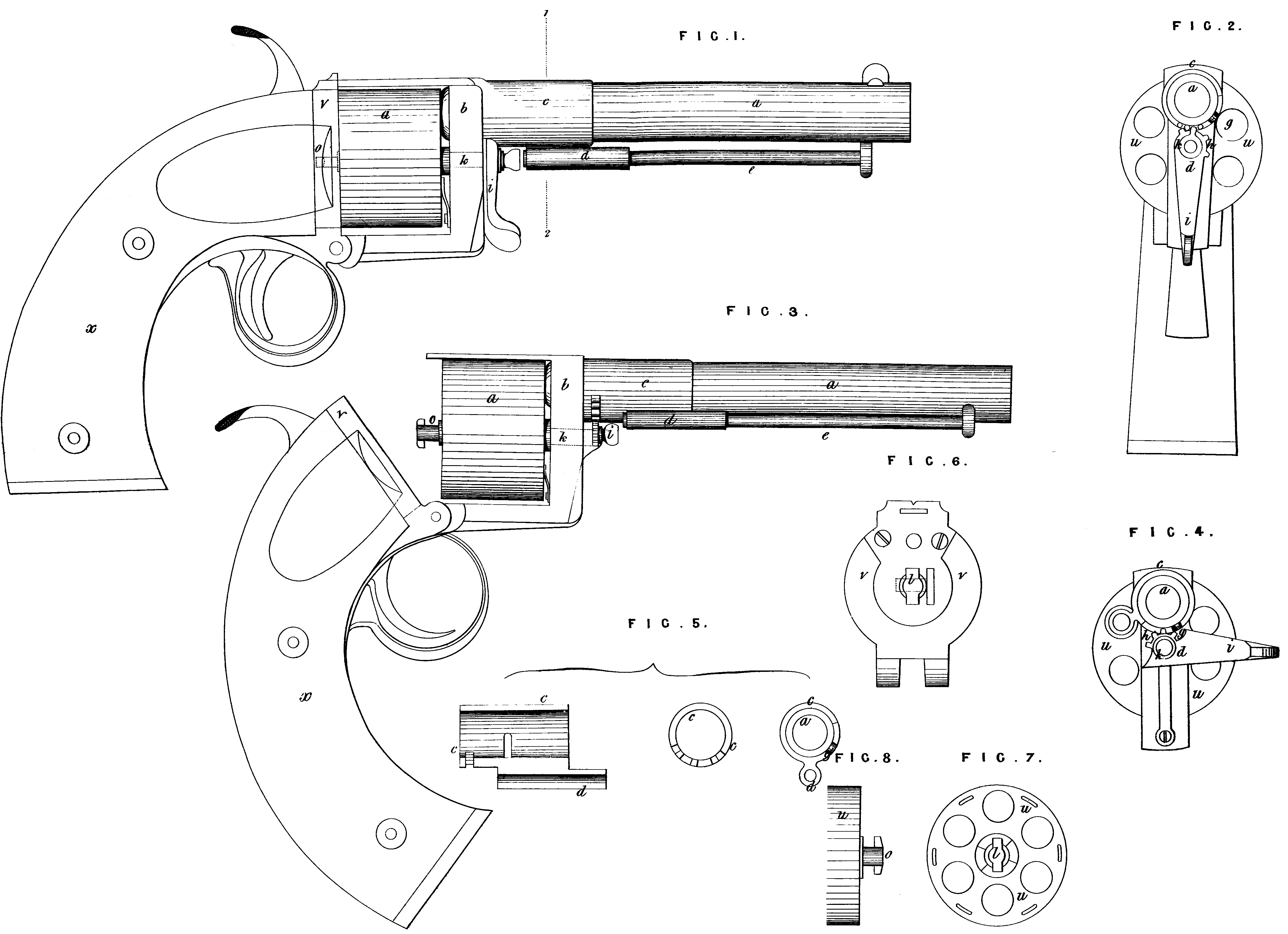Britain 2990
A.D. 1858, 30th DECEMBER. N ° 2990.
Revolving Fire-arms.
LETTERS PATENT to Richard Archibald Brooman, of 166, Fleet Street, in the City of London, E.C., Patent Agent, for the Invention of “Improvements in Revolving Fire-arms”— A communication from L. F. Devisme, residing at Paris.
Sealed the 28th June 1859, and dated the 30th December 1858.
PROVISIONAL SPECIFICATION left by the said Richard Archibald Brooman at the Office of the Commissioners of Patents, with his Petition, on the 20 December 1858.
I, RICHARD ARCHIBALD BROOM AN, of 166, Fleet Street, in the City of London, E.C., Patent Agent, do hereby declare the nature of the said Invention for “Improvements in Revolving Fire-arms,” (communicated to me by L.F. Devisme, residing at Paris,) to be as follows:—
This Invention consists in so forming and fitting the revolving breech piece of revolving fire-arms, that when they have to be charged it may be turned either downward or to one side, or otherwise about a hinge or joint either in conjunction with or separate from the barrel, and in fixing the said; breech piece in place after the chambers have been charged by means of a rod passing through the breech piece, and engaging at the rear end in a female screw thread or other holding part by means of a male screw thread, or, a male screw thread, or a gaining, or other projection.
Fig. 1 is a side view of a fire-arm constructed according to this invention; Fig. 2 is a section through the line 1, 2; Fig. 3 shows the arm open, and the positions the ramrod and other parts then assume; and Figs. 4, 5, 6, 7, and 8, are views of the details. The arm is composed of two parts: the first comprises the barrel a, the ramrod e, the cartridge holders or revolving chamber u, the mechanism which causes these parts to revolve, and the brace or holder b. The second comprises the breech-piece v, the stock x, and the interior mechanism which works the trigger and hammer. The barrel a has a part thinned off near the brace b, in which a ring c is fixed, to which a piece of metal d is cast or attached, forming a socket for the reception of one end of the ramrod e. In the ring c a series of notches is formed, in which the teeth of a toothed sector h take to cause the ring c to revolve. This toothed sector h forms part of a lever i, the centre of which is at k, so that when this lever is placed in a perpendicular position the ramrod will be underneath the barrel, but when it is in the position shown at Fig. 2, the ring being drawn by the toothed sector h, say a quarter of a turn, causes the ramrod to occupy the position indicated at Fig. 4. This lever i also produces the rotation of the cartridge holders in the following manner:
The centre k of the lever i consists of a rod which passes through the cartridge chamber, and terminates in a T-piece or projection o; a groove l is formed in the stock to receive this piece o, and when the lever is taken from the position it is shown in at Fig. 4 to that in Fig. 2, the T-piece takes into notches formed in the interior of the groove l,and holds the chamber firmly closed. A pin g limits the distance the ring c travels. By the simple movement of the lever i the opening of the breech and the bringing of the ramrod into position for use are produced.
The T-piece o can be replaced by a screw taking into a corresponding thread formed in the groove in the breech. The discharge of the cartridge holders can also be produced by means of a rod terminating in a circular piece or washer, having holes formed therein corresponding with those in the cartridge holder ; the cartridges rest against this washer, so that a simple push of the rod will suffice to disengage the whole of the cartridges.
And having now described the nature of the said Invention, and in what manner the same is to be performed, I declare that I claim the improvements in revolving fire-arms herein-before described and illustrated in the accompanying Drawings.
In witness whereof, I, the said Richard Archibald Brooman, have hereunto set my hand and seal, this Thirtieth day of June, One thousand eight hundred and fifty-nine.
R. A. BROOMAN. (L.S)

